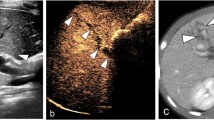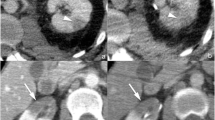Abstract
Forty-six consecutive children with blunt renal injury were evaluated retrospectively to assess the diagnostic accuracy of the different imaging methods, including ultrasonography (US), intravenous pyelography (IVP), and computed tomography (CT), and to determine the optimal radiologic management. Doppler ultrasonography was never performed in an emergency. Classification of the 46 renal injuries was as follows: 25 contusions, 4 lacerations, 11 ruptures, and 6 pedicle injuries. The diagnostic accuracy of IVP (80.8%) was superior to the diagnostic accuracy of US (41%) in all types of renal injuries. IVP should be performed as an emergency procedure when macroscopic hematuria is present, or when an isolated renal injury is clinically suspected. Microscopic hematuria alone is no longer an indication to perform IVP. Asymptomatic patients with microscopic hematuria should have US examination and should be observed with performance of serial urine analyses. Multiply injured and hemodynamically stable children should be evaluated by contrast-enhanced CT. Hemodynamically unstable children should undergo immediate exploratory laparotomy, if it is indicated after assessment by imaging.
Similar content being viewed by others
References
Lowe P, Hardy BR (1982) Isolated bilateral blunt renal trauma with pelviureteric disruption. Urology 9: 420–422
Carroll PR, Klosterman PW, McAninch JW (1988) Surgical management of renal trauma: analysis of risk factors, technique, and outcome. J Trauma 28: 1071–1077
Guice K, Oldham K, Eide B, Johansen KAJ (1983) Hematuria after blunt trauma: when is pyelography useful? J Trauma 23: 305–310
Cass AS (1982) Immediate radiologic and surgical management of renal injuries. J Trauma 22: 361–363
Civil ID, Schwab CW (1988) The abbreviated injury scale, 1985 revision: a condensed chart for clinical use. J Trauma 28: 87–90
Mogensen P, Agger P, Ostergaard AH (1980) A conservative approach to the management of blunt renal trauma. Br J Urol 53: 338–341
Yale-Loehr AJ, Kramer SS, Quinlan DM, La France ND, Mitchell SE, Gearhart JP (1989) CT of severe renal trauma in children: evaluation and course of healing with conservative therapy. AJR 152: 109–113
Carroll PR, McAninch JW, Klosterman P, Greenblatt M (1990) Renovascular trauma: risk assessment, surgical management, and outcome. J Trauma 30: 547–552
Cass AS (1983) Renal trauma in multiple-injured child. Urology 11: 487–492
Gwinn JL, Stanley P (1980) Urinary tract trauma in diagnostic imaging in pediatric trauma. Springer, New York Berlin Heidelberg, pp 2–17
Monstrey JM, Vander Werkwen C, Debruyne FMJ, Goris RJA (1988) Rational guidelines in renal trauma assessment. Urology 31: 469–473
Bass DH, Semple PL, Cywes S (1991) Investigation and management of blunt renal injuries in children: a review of 11 years's experience. J Pediatr Surg 26: 196–200
Oakland CDH, Britton JM, Charlton CAC (1987) Renal trauma and the intravenous urogram. J R Soc Med 80: 21–22
Karp MP, Jewett TC, Kuhn JP, Allen JE, Dokler ML, Cooney DR (1986) The impact of computed tomography scanning on the child with renal trauma. J Pediatr Surg 21: 617–623
Leppäniemi AK, Haapiainen RK, Lehtonen TA (1989) Diagnosis and treatment of patients with renal trauma. Br J Urol 64: 13–17
Kay CL, Rosenfield AT, Armm M (1980) Gray-scale ultrasonography in the evaluation of renal trauma. Radiology 134: 461–466
Kaufman RA, Towbin R, Babcock DS, Gelfand MJ, Guice KS, Oldham KT, Noseworthy J (1984) Upper abdominal trauma in children: imaging evaluation. AJR 142: 449–460
Teele R, Share J (1991) Ultrasonography of infants and children. Saunders, Philadelphia, p 365
Siegel MJ, Balfe DM (1989) Blunt renal and ureteral trauma in childhood: CT patterns of fluid collections. AJR 152: 1043–1047
Fuchs WA, Robotti G (1983) The diagnostic impact of computed tomography in blunt abdominal trauma. Clin Radiol 34: 261–265
Author information
Authors and Affiliations
Rights and permissions
About this article
Cite this article
Mayor, B., Gudinchet, F., Wicky, S. et al. Imaging evaluation of blunt renal trauma in children: Diagnostic accuracy of intravenous pyelography and ultrasonography. Pediatr Radiol 25, 214–218 (1995). https://doi.org/10.1007/BF02021540
Received:
Accepted:
Issue Date:
DOI: https://doi.org/10.1007/BF02021540




